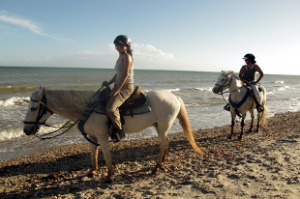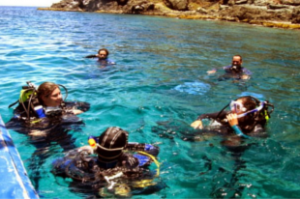Margarita Island is the largest island in the Venezuelan state of Nueva Esparta, situated off the northeastern coast of the country, in the Caribbean Sea. The capital city of Nueva Esparta, La Asunción, is located on the island. Primary industries are tourism, fishing and construction.
It’s a popular holiday destination, comprising 2 peninsulas linked by the sand and mangroves of the Parque Nacional Laguna de la Restinga national park. Most people live, or stay, on the eastern peninsula, home to the cities of Pampatar, Porlamar and La Asuncion.
Area: 1,020 km2
Currency: Bolívar (Bs)
Language: Spanish
Population: 436, 900
Weather
The island’s climate is tropical dry and semi-arid characterized by relatively high temperatures and low rainfall. Temperatures are stable throughout the year, the island has an annual average temperature of 28°C. The average maximum temperature vary between 32.8°C in September and 30°C in January, while the average minimum temperature vary between 23.2°C in January and 25.5°C for the months of September and October.
Religion
The predominant religion is Roman Catholicism. Other Christian denominations are also present. Of the churches that present in the Neospartan entity, among the most important are: Basílica de la Virgen del Valle (in the Valley of the Espíritu Santo), Cathedral of La Asunción, Iglesia San Juan Evangelista (Juangriego), Iglesia parroquial de San Juan (San Juan Bautista), Iglesia de San Nicolás de Bari (Porlamar), of the San José de Paraguachi and other churches and chapels minor located in populations of Santa Ana, Punta de Piedras, Porlamar, Pampatar and virtually all the towns of the island. There are also small populations of Jews and Muslims.
Evangelical Christian churches have had a significant growth in recent years demonstrating their presence and impact in the population of the island. One of the fastest-growing is the Centro Cristiano Casa de Alabanza (CCCA), present in Porlamar, Juan Griego, La Asunción and Tubores Municipality.
Health and Safety
Like most areas of the world it is best in Margarita to use caution late at night and try not to walk about alone in unfamiliar areas unless in a larger group of people who are familiar with the locality. Leave your jewelry at home, you will not need it here. A cheap watch is all one may need.
Avoid taking buses. It is better to take a taxi cab. They are cheaper and can be requested by phone.
If you got robbed, please stay calm and avoid a fight with the thief.
Do not give information to strangers and be discreet when talking on the phone in public.
Please carry a copy of your passport with you and leave the original one at home.
The downtown of Porlamar and Juan Griego are dangerous.
Do not walk on the streets after 7:00PM.
Avoid deserted beaches and streets.
Book your tours in travel agencies.
Carry your backpack in front of you.
Avoid crowed places.
There are several public and private medical clinics on Margarita.
Farmacias SAAS, Centro Comercial Galerías, Av 4 de Mayo.
Hospital Central Dr Luis Ortega. Centrally located clinic with pharmacy.
Dental work is normally quite reasonably priced on Margarita Island. Many dentists have modern facilities and have trained in the US or EU.
Getting Around
Taxis hire is subject to prior negotiation with the driver. Taxis can often be chartered for a day if required. Most of the taxi have fix rates and should be inexpensively priced. The taxi painted in white with yellow license plate are often considered to be the most reliable.
Por puesto service most of the island. These are a little like a shared taxi having much more flexibility than a conventional bus service. Many locals use the Por Puesto services which normally travel a fixed route offering a cheap and safe alternative to a taxi. The journey can sometimes be a little slow however, as they often stop to pick up and discharge passengers at frustratingly short intervals and this may draw a trip out considerably.
Buses run to the most destinations in daytime only. Typical service hours are daily from 6AM-8PM with reasonably priced fares. Flag the bus down if you are on the side of the road and want it to stop. Check the rate to your destination with the driver as you board the bus and pay when you arrive. The local buses may be a little too rustic for some visitors used to more modern transportation systems but they are a good inexpensive way to get about and to meet the local people.
Buseta (mini-buses) offer an opportunity to travel cheaply and to get in touch with the locals. Trip times will depend on distance and traffic conditions. Knowing a little Spanish is always helpful to get through, but some locals will be pleased to practice their English with you. Fares are inexpensive and depend on the length of your travel. Before boarding a mini-bus, ask the driver how much the fare is to your specific destination to ensure there are no misunderstandings.
Car Rentals: Rental cars, Crazy Car Hire, Europcar.
Cities
Porlamar
The largest city on Margarita Island is Porlamar. The population can reach 125,000 in the high season, while in the low season, the population is about 85,000. Two beaches are located within the city.
La Asunción
La Asunción is the capital of the Federal State of Nueva Esparta with a population of around 28,500. It is the seat of the regional government. The city is overlooked by the Santa Rosa Castle of La Asunción
Pampatar
The urban area of Pampatar has a population of around 50,000. A number of the island's larger shopping malls are located in the city, namely Sambil Margarita, Rattan Depot, Centro Comercial La Vela, Centro Comercial Costa Azul, Centro Comercial AB (Avenida Bolivar) and La Redoma. The Royal Fortress of San Carlos Borromeo, constructed in the late 17th century, is located in Pampatar. The city also has several beaches.
Juan Griego
Juan Griego is a city on the northern side of Isla Margarita, and is the most northern port in Venezuela. It has a population of 28,256 inhabitants (as per census of 2001) and is capital of the Marcano municipality of the Nueva Esparta state. Its church of gothic styling was constructed in 1850 by Fray Nicholas de Igualdad is still, along with the lovely bay, the symbol of the city. The La Galera fortress, where in the early 1820s a fierce battle for independence was fought, is located near the city centre. In 1973, the island become a free port and the city once again become the second city in sequence of importance in the commercial activities after Porlamar.
Margarita Island Beaches
Playa el Agua
Playa el Agua is by far Margarita's biggest and most popular beach. It is a fine sand beach, lined with palm trees, over 4 kilometers long. There is a boulevard running behind these palm trees for all of the beach's length, and on it you will find a line of restaurants, hotels, and shops. You can rent beach chairs and umbrellas from these outlets, plus most of them offer showers and toilets.
Playa Guacuco beach
Playa Guacuco is situated on the eastern coast of Margarita island. You get there only by following a fairly small countryside road. When going north, turn right at the big crossing that is at La Asuncion and follow the signs.
The beach itself is quite pretty, with palm trees reaching near the water, and fairly calm waves. Guacuco is a narrow beach - there is not much distance from your beach chairs to the water.
The beach gets its name from clams - you can basically stand in the shallow waters, reach down into the sand, and pick them. At places, the sand on the beach itself is almost covered with lots of shells and shell pieces.
Playa Parguito has nice, white sand, with occasional small seashells. The waves of clear water can be quite high and rough for swimming, with choppy or rolling waves - but are great for surfing. The sourthern end of the beach attracts surfers, and even some surf contests are held on Parguito beach.
Playa Parguito
Playa Parguito is quite popular among the locals, and the beach is usually full during the weekends and Venezuelan holidays. Since the beach is not very wide, this can make it a little crowded on those times, but had relatively few people when we went.
El Yaque
El Yaque is a beach where windsurfers, kitesurfers, and families with small kids enjoy the sun and beach together. El Yaque used to be a small fishing village. It is still small, but now it is an internationally known windsurfers' mecca. The beach enjoys a consistent wind most of the year, plus the waters are very shallow, making it an ideal windsurfing place.
Juangriego beach
Juangriego beach is located right at the little quaint Juangriego town. The town streets reach practically to the shore, so you can step right into the stores from the beach.
This beach is fairly small, and very nice for little kids as it is shallow and there are no big waves. It is not among the popular tourist beaches but the locals flock it during kids' summer holidays. A dock for fishing boats is bordering the beach on the north side.
Playa Galera beach
Playa Galera is found at a small bay right after Juangriego bay. You will find the beach after passing by the fort ruins of Fortin de La Galera and continuing north. This beach offers shade huts, Jet Ski rentals, and restaurants.
Playa Galera beach is about 1200 meters long. The beach is not very wide, but the waters are especially calm at this bay, and therefore very suitable for children. Playa Galera beach is also a good place to watch the sunset (as also is the Juangriego beach or bay). The beach is lined with restaurants where you can observe the beauties of the evening sun. The beach is not safe for swimming.
Playa La Guardia beach
This beach continues on for miles. It is just a narrow strip of land connecting Macanao peninsula to the main part of Margarita island.
It is not a sandy beach but filled with smaller and bigger rocks rounded by the waves, and lots and lots of seashells. The air is cooler here than at many other beaches, with constant strong wind.
Accommodation
Activities
 |
 |
 |
| Ranch Cabatucan | Isla Margarita Golf Club | Scubadiving Margarita |
 |
 |
|
| Diving Margarita | Museo Marino de Margarita |
 |
 |
 |












